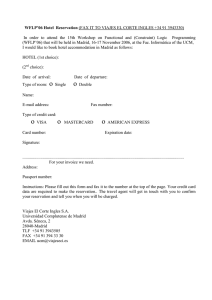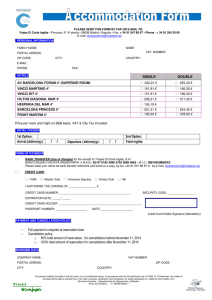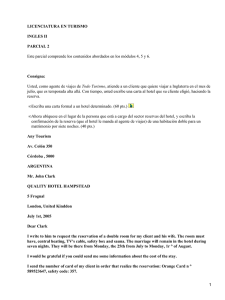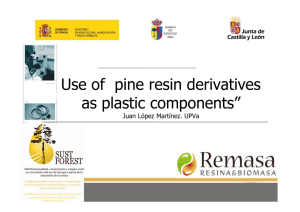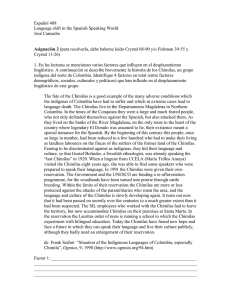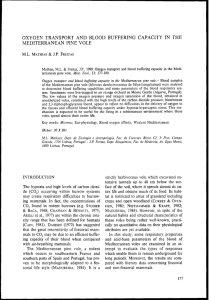Revitalization of Lakhota language on Pine Ridge Reservation
Anuncio
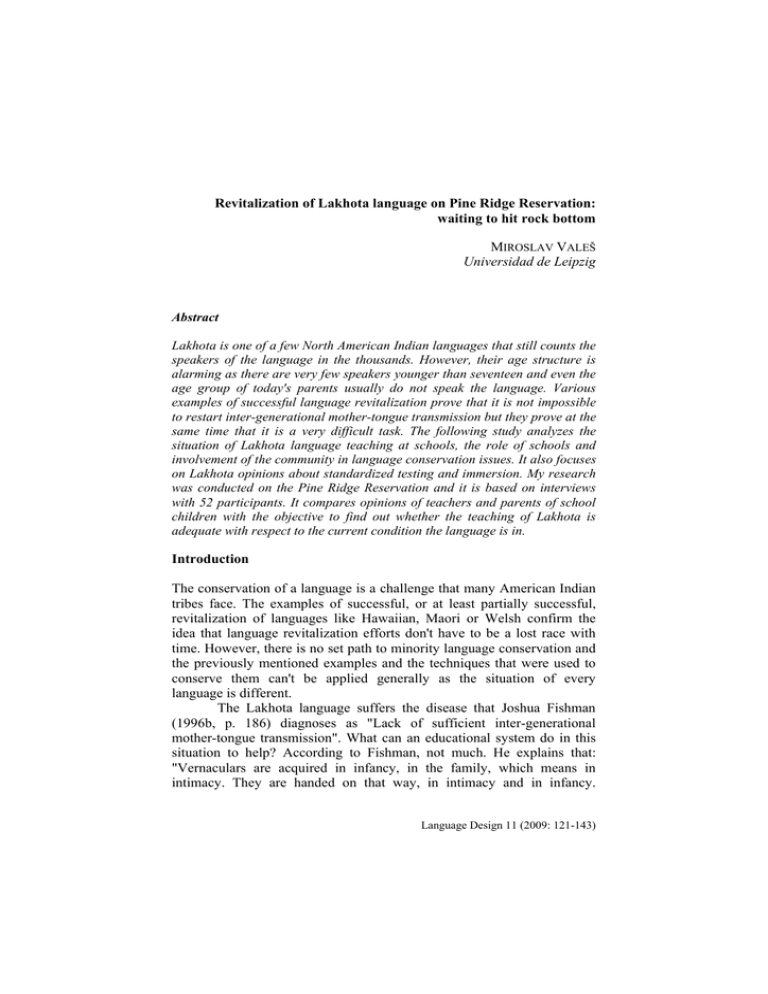
Revitalization of Lakhota language on Pine Ridge Reservation: waiting to hit rock bottom MIROSLAV VALEŠ Universidad de Leipzig Abstract Lakhota is one of a few North American Indian languages that still counts the speakers of the language in the thousands. However, their age structure is alarming as there are very few speakers younger than seventeen and even the age group of today's parents usually do not speak the language. Various examples of successful language revitalization prove that it is not impossible to restart inter-generational mother-tongue transmission but they prove at the same time that it is a very difficult task. The following study analyzes the situation of Lakhota language teaching at schools, the role of schools and involvement of the community in language conservation issues. It also focuses on Lakhota opinions about standardized testing and immersion. My research was conducted on the Pine Ridge Reservation and it is based on interviews with 52 participants. It compares opinions of teachers and parents of school children with the objective to find out whether the teaching of Lakhota is adequate with respect to the current condition the language is in. Introduction The conservation of a language is a challenge that many American Indian tribes face. The examples of successful, or at least partially successful, revitalization of languages like Hawaiian, Maori or Welsh confirm the idea that language revitalization efforts don't have to be a lost race with time. However, there is no set path to minority language conservation and the previously mentioned examples and the techniques that were used to conserve them can't be applied generally as the situation of every language is different. The Lakhota language suffers the disease that Joshua Fishman (1996b, p. 186) diagnoses as "Lack of sufficient inter-generational mother-tongue transmission". What can an educational system do in this situation to help? According to Fishman, not much. He explains that: "Vernaculars are acquired in infancy, in the family, which means in intimacy. They are handed on that way, in intimacy and in infancy. Language Design 11 (2009: 121-143) 122 Miroslav Valeš Schools teach and students learn, even languages sometimes, but schools are programmed and not generally inter-generational institutions (1996b)." Nettle and Romaine state a similar opinion: "When a language is no longer being passed on at home, efforts to promote it outside that domain – in church or school, for instance – usually end up being symbolic and ceremonial" (2000, p. 178). The Lakhota language is in a situation where inter-generational transmission has already been interrupted. The parents can not pass on the language even if they wanted to as they don't speak it themselves. School by itself is not able to save a language but it can support the effort of the whole community. When a language is taught at school it gives the language more prestige and it positively influences the overall attitude to the language. There are general conditions that are favorable to language maintenance and various studies (Hinton – Hale, 2001; Zimmermann, 1999; Šatava, 2001) have proved that one of the most important factors for language conservation is the attitude of the speakers or ethnic population to the language and its prestige within and outside of the community. Akira Yamamoto (1998, p. 114) established the following 9 factors that contribute to the conservation and development of minority languages: 1. The existence of a dominant culture in favor of linguistic diversity. 2. A strong sense of ethnic identity within the endangered community. 3. The promotion of educational programmes about the endangered language and culture. 4. The creation of bilingual/bicultural school programs. 5. The training of native speakers as teachers. 6. The involvement of the speech community as a whole. 7. The creation of language materials which are easy to use. 8. The development of written literature, both traditional and new. 9. The creation and strengthening of the environments in which the language must be used. When we examine the situation of Lakhota we find that at present there is good support for linguistic diversity from the dominant culture, although it sadly comes after decades of linguistic oppression. There is also no doubt about the feeling of ethnic identity and pride of being Lakhota. Members of the tribe claim with pride that they are "full-bloods" while being a "half-breed" is considered to be of a lower rank. On the other hand there is not much literature in Lakhota because all the descriptions of Revitalization of Lakhota language on Pine Ridge Reservation:… 123 Lakhota traditions, myths and history are in English. Another field that still needs to be reinforced is the environments where Lakhota must be used. At present there are practically none other than a few traditional ceremonies. There are not many studies that concentrate on language teaching issues among the Lakhota. In 1999 Marion BlueArm analyzed the situation on the Cheyenne River Reservation based on surveys conducted in 88 households and she found that: "Over 80% of respondents agreed or strongly agreed with issues that support language preservation efforts (BlueArm, 2002. p. 162)." However, she also disclosed that Lakhota language issues do not necessary have support, which led her to recommendations that might seem unrealistic: "People should voluntarily ban television and other forms of modern media entertainment from their homes, at least for certain hours or within certain contexts (BlueArm, 2002, p. 171)." The objective of the investigation that I carried out on Pine Ridge Reservation in 2007 was to analyze the situation of Lakhota language teaching in schools and the attitude of the teachers and parents of school children to Lakhota. The study focuses on the questions of whether the measures that are taken in Lakhota teaching are adequate to the situation of the language, how much the community is involved in the language conservation and whether the tribe members are ready to make the effort necessary to save the language. In general, the analysis examines the role of school in language conservation efforts and the conditions for its conservation. My motivation was to document the situation as it was in 2007. The study is a snap shot reflecting this moment when the Lakhota language was passing through difficult times. The situation is evolving dynamically and I hope that some of the less positive elements in my observations will be gainfully changed in the near future. Lakhota history and language Ullrich’s research of the Lakhota inform us of their position among the typical plains cultures though they only came into the area of the Great Plains in the 17th and the 18th century from present day Minnesota. They migrated to the northern Great Plains expanding their territory at the cost of neighboring tribes and we can still find allusions to this migration in some of their legends (Ullrich, 2002). The whole Lakhota Nation has been traditionally divided into seven tribes according to the Seven Council Fires: Oglála, Sičháŋğu (Brulé), 124 Miroslav Valeš Mnikhówožu, Itázipčho, Oóhenuŋpa, Húŋkpapha and Sihásapa. Before 1850 the Lakhota had only minimal contact with European culture but in the second half of the 19th century they were gradually colonized in a series of wars. The milestones of the colonization were the First and Second Laramie Treaties (1851, 1868) that established the boundaries of the Great Sioux Reservation that originally included the Black Hills. Another important event that is a source of pride up to the present day was the victorious Battle of Little Big Horn against General Custer and the 7th cavalry in 1876. Finally the Massacre of Wounded Knee in 1890 concluded the attempts of Lakhota resistance and disrupted the emerging tradition of the Ghost Dance, a dance that was supposed to chase the "wašíču" (whites) out and bring back the good old times. The Lakhota were settled in reservations in South Dakota (Pine Ridge, Rosebud, Cheyenne River, Standing Rock and Lower Brule), Montana, Minnesota and Canada where most of them still live now (Johnson, 2000). The Siouan Language Family consists of 16 languages most of which are either extinct or almost extinct. The Lakhota language forms the Siouan-Proper branch together with Santee-Sisseton (Dakota), YanktonYanktonai (Dakota), Assiniboine (Nakota) and Stoney (Nakoda). Lakhota is not related to most of its traditional neighbors and allies such as Arapahoe and Cheyenne which are both Algonquian languages. Surprisingly, the traditional enemies of Lakhota, the Crow, use a Siouan language. Today the situation of Lakhota is similar to many other American Indian languages. Even though it still has a relatively high number of fluent speakers their age structure is alarming. According to Oceti Wakan (2007) 19% of people on the Pine Ridge Reservation can speak Lakhota (1,649 out of 8,886 interviewed) but only 2% under the age of 6 and 3% of children and youth between 7 and 17 years of age. On the other hand in the generations of 50 years and older it is 58%, which means that the speakers of the language are gradually passing away and the coming generations do not speak the language any more. It also means that without immediate action the language might disappear in the not very distant future. One serious issue hampering Lakhota language teaching and learning is the lack of standardized orthography. The phonology of Lakhota language includes a few sounds that do not exist in standard American English creating a problem for their transcription. For this reason, everyone who makes materials for teaching uses their own standard, which, of course, creates a difficult environment for the Revitalization of Lakhota language on Pine Ridge Reservation:… 125 educators. For this reason the survey conducted at Pine Ridge included a question for the teachers of Lakhota on what materials they use for teaching with the objective of finding out how they deal with this problem. An example of different transcription styles could be the Lakhota words for sage [phe'i:χota] and chokecherry [t∫haŋ'pχa]: These few examples demonstrate that standardization of orthography would be very useful for the Lakhota language. The publication of New Lakota Dictionary (LLC, 2008) might change the situation in the near future. Methodology In the year 2007 I carried out a research study on the Pine Ridge Reservation the objective of which was to monitor the situation of Lakhota language teaching in schools and to assess the attitude to Lakhota language teaching issues. This study was part of a larger project focused on general attitudes to the language and the relation between language and identity. In the course of the project 52 members of the Oglala Lakhota tribe were asked to answer 15 questions in a questionnaire, which was recorded in the form of an interview if the participant agreed. More than 90% of them agreed with the recording. The reasons for recording were multiple, first, some of the questions were open ended and if not recorded, the participants would have to write extensively, which would probably have discouraged them and made them respond in a simpler form. Second, it 126 Miroslav Valeš was frequently found that the participants were expressing their opinions about the language teaching issues throughout the whole session, giving interesting comments and explanations to yes/no questions or simply expressing their opinions when they had them. Another reason was that the recorded answers opened space for more detailed analysis. As the objective of this study was to compare opinions of teachers and parents about Lakhota teaching at schools, the 52 subjects consisted of 22 teachers and 30 parents of school children. The questionnaires were different for these two factions because of their group-specific content. In the paper I have used 34 excerpts (numbered and written in italics) from the interviews to support the points in individual sections. The questions analyzed in this study can be found in the appendix of this paper. The analysis takes into account that the data was collected in rather formal interviews and for this reason they needed a careful interpretation. The subjects knew that the interview was about the Lakhota language and some of them might have been inclined to answer in a way to please the interviewer. After answering one of the questions a participant even asked: "Is that right?" as if there were right and wrong answers. Teachers on the other hand frequently misinterpreted question 1 (How many Lakhota classes do the children have each week at your school?) explaining instead how many classes they teach to justify that they work hard enough. However these examples only mean that the data needs to be approached carefully in the context of the situation. Sometimes even the information for which the participant considers some answer as "the correct one" can provide valuable insights. History of Lakhota language on the reservation The history of education on Pine Ridge Reservation has not been very accommodating to the Lakhota language. The first educational institutions, boarding schools, caused a major disintegration of the Lakhota language and society in general. These schools started to be used on other Indian reservations in the 1870's and after the complete colonization of Lakhota they were introduced in Pine Ridge at the end of 19th century. The native language was forbidden and the students were punished for using it far into the 20th century. A parallel progression was endured by other native languages and the general guidelines are described in Federal Language Policy and Indigenous Languages in the United States, Hinton (2001a). Many people who are 40 years old or older still recall their traumatic experience from these institutions [1]: Revitalization of Lakhota language on Pine Ridge Reservation:… 127 [1] I was punished for speaking my language, and that was 1958, and corporal commissions still existed until 1973. As a consequence of this education and as a result of a general social climate that considered everything Native inferior the parents decided not to pass their vernacular language to the next generation to prevent their children from similar humiliations they suffered for speaking Lakhota. One teacher summarized his experience in a simple sentence [2]: [2] When I was young, it was not cool to speak the Indian language, others were laughing at you and so I didn't want to speak it. Eighty years of this attitude caused the situation that the average age of a Lakhota speaker is about 65 and the gap of two or three generations of non-speakers is now difficult to bridge. After the long period of linguistic oppression the situation slowly started to change with the 1968 Bilingual Education Act and the 1975 Lau Remedies, which provided funding for bilingual education. Nevertheless, the practices of boarding schools were still used in the 1970's. Since the 1980's there have been efforts to revitalize the language and most schools currently have Lakhota language as part of their curriculum. Nevertheless these efforts have not been very successful and have not managed to stop or slow down the declining number of young speakers. Where should the children learn to speak Lakhota? According to Fishman (1996b) and others the answer to this question is: "at home - in family, in intimacy and in infancy." However, many languages, including Lakhota, are facing the situation where this is no longer possible as the gap of non-speaking generations is too wide. Today's parents do not speak Lakhota and not even many of the grandparents do. In the interviews carried out in Pine Ridge, 4 out of 30 parents answered they could speak Lakhota, which is only 13%. However, sometimes it is possible to learn the language from older members of the family. The survey carried out by Oceti Wakan (2007) claims that in 51% of all households someone speaks Lakhota, for this reason many children can still learn the language at home. Many others don't have this opportunity though and school remains the only accessible option for them. 128 Miroslav Valeš teachers parents at home 3 (14%) 2 (7%) at school 0 0 both 19 (86%) 28 (93%) total 22 30 Table 1: Results of question 2: (Where do you think children should learn to speak Lakhota?) parents frequently 8 (27%) sometimes 13 (43%) never or almost never 9 (30%) total 30 Table 2: Results of question 3: (Do you help your children to learn Lakhota?) In spite of the hypothesis that teachers would say the language should be learned "at home" while parents would say "at school" the results of the survey demonstrate that both teachers and parents agree that it should be a joint effort of school and family to teach the children the Lakhota language. The opinion [3] nicely summarizes the opinion of many interviewees. [3] I'd say at home but then a lot of parents don't speak it and so the only place they can learn it is at school, actually both, ... In spite of these proclamations the reality seems to be different. Only 27% of parents claimed that they frequently help their children to learn Lakhota and 30% admitted they never do so. Surprisingly even one of the four parents who speak Lakhota admitted he never teaches his children the language. Moreover these figures need to be considered in the context of the questionnaire about the language. It is very likely that most parents exaggerated their effort and for this reason the answer "sometimes" might be just another way for saying "almost never". In the reports of the teachers [4] to [8] we can see that one of their frequent complaints was that parents do not reinforce the effort that the school makes in language teaching. In [8] they even talk about notes on returned progress reports saying that Lakhota is of no importance. [4] Many of the parents are dropping the ball. [5] No support from home. [6] It is not taught at home. [7] We can do what we have to here but whenever it's not enforced at home it's never gonna work. Revitalization of Lakhota language on Pine Ridge Reservation:… 129 [8] I have some parents who write at the bottom of the weekly report: "Lakhota language is not important in our home, so don't teach it". [9] I think there is a chance that we can bring it back, it's got to start at home in families, we cannot rely on the schools, to give the school the burden to bring it back, otherwise they teach it at school and the kids go back home and they won't speak it so they won't understand what they are teaching at school so it's not gonna help. Teaching the language at school has a positive influence on the status of the language but on the other hand it provides an excuse for many parents to pass the responsibility to someone else. Despite the exceptional occurrence of opinion [9], the participation of parents is vital for the success of Lakhota revitalization yet many of them have still not made this realization. Even though it would be ideal if the children learned the language at home, there are two obstacles to be overcome first. The first one is that many children don't have anybody in the household who would speak the language and the second one is that many of the speakers are not ready to pass on the language. For this reason it seems to be more viable for the children to acquire the language at school. However, this would lead to Lakhota being learned as a second, non-vernacular, language and the society would need to strongly reinforce the environments where the language has to be used. Otherwise there is the danger of repeating the mistakes of Irish revitalization (Fishman, 1996a) where many people actually learned the language but large numbers do not use it. The gap between second language and mother tongue is wide and it is unsafe to assume that the children who learn Lakhota as a second language would use it with their own children as the first language. When we look at the example of Basque revitalization this eventuality happened frequently but the whole community made an enormous effort and created many situations where Basque had to be spoken (Etxebarria, 2002). This however is not a task for the school but rather a challenge for the whole community. Attitudes to Lakhota language teaching When we look at the present situation in schools we first have to examine carefully the objective of Lakhota language teaching. What is or what should be the objective? Evidently, the objective should be to make the children proficient, fluent speakers who feel confident and comfortable speaking the language. The children should reach the level of fluency that 130 Miroslav Valeš makes them speak completely naturally without any special effort. This objective might seem rather exaggerated and unrealistic but only this level of knowledge can assure that the children won't hesitate to use the language as they won't have to make any special effort to use Lakhota instead of English. It is obvious that this level of proficiency is not easy to achieve in second language learning but many examples of people who reached this level confirm that it is not impossible. If the children learn 500 words and a few traditional stories, they will have a good idea about the life and the language of their ancestors but they will never be able to pass the language to the next generation. From the point of view of language conservation, learning 500 or 1000 words or nothing is very similar. Only the speakers that are fluent and confident in the language may possibly pass it to the next generation and contribute to its conservation. The objective is different from learning a second language for general use in a foreign country or to do business with a foreign company. The mere ability to communicate and understand on an intermediate level is not enough to restart the inter-generational transmission. The objective may seem impossible to achieve in the current educational system, but it simply cannot be any lower, because anyone with less than a highly proficient speaking ability cannot positively aid the language conservation effort. It is difficult to imagine that people would speak to their children in a language that they haven’t mastered completely. The attention that Lakhota receives at schools varies greatly depending on who operates the school. There are three basic types of schools on the Pine Ridge Reservation: BIA schools, State schools and Church schools. At the elementary level the time dedicated to the Lakhota language or Lakhota studies oscillates between 30 and 150 minutes a week. At the high school level it is between 60 and 250 minutes. The figures are generally lower for State schools and higher for BIA and Church schools. It is evident that teaching the language once or twice a week is rather symbolic and the students cannot achieve the above described objective. Only the schools that teach Lakhota five times a week can possibly be successful. The opinions [10] and [11] exemplify that not enough time dedicated to Lakhota was one of the most frequent complaints of the teachers. [10] Not enough classes for the language. [11] Just small amount of time that I have them. Revitalization of Lakhota language on Pine Ridge Reservation:… 131 [12] It's misunderstanding of the language, you know what I mean, the language should be primary, it should be first, essential thing. Not Social studies and you hook a language, you know, terms with it, vocabulary. I think that the language should come first and then you should introduce these other subject matters in the language, and they are doing it backwards, they are doing it in the other way, they are doing Social studies and let's give the vocabulary to what you're teaching. YES undecided NO total 17 (77%) 3 (14%) 2 (9%) 22 teachers 28 (94%) 1 (3%) 1 (3%) 30 parents Table 3: Results of question 6: (Do you think the children should have more Lakhota classes at school?) In question 6 most teachers and parents agreed that children should have more Lakhota classes at school. It is notable that some parents were not afraid of saying that the children should have more Lakhota classes instead of subjects like reading, writing or math. Another issue that teachers mentioned frequently was the relation between Lakhota language and Lakhota studies as expressed in opinion [12]. The teachers complained that the newly introduced subject Lakhota Studies (called Social studies in [12]) embraces language and culture, which provides even less space for Lakhota language teaching than they had before. This way the Lakota teaching is limited by cultural studies and its accompanying introduction to the language. Considering the position of the language it is surprising that there are not many schools that teach the language five times a week. Instead there are some that only have Lakhota studies and many that teach the language symbolically as if the language had already died and there were no need to do anything about it. Regarding the orthographic inconvenience, the survey revealed that most teachers use Lakhota Language Consortium materials but another frequent answer to question 3 (What books or materials do you use for teaching?) was "own materials". Opinion [13] exemplifies that the orthography issue is important for the teachers, and some of them choose their teaching materials according to the orthography that is used. The answers to question 3 prove that the orthography issue can seriously hamper the teaching process and prevent teachers from using 132 Miroslav Valeš methodologically advanced materials only because the orthography provided there is disliked by or unknown to teachers. [13] Own materials. I don't use LLC books because of the orthography. The answers to question 3 also demonstrate that there is no standard curriculum for teaching the Lakhota language. Every school uses different materials and these frequently change with the change of teacher or school administration. The consequence for the children is that they forever repeat numbers, colors and animals in Lakhota but they rarely get any further. We gain additional information about problems with teaching materials in question 4 (What is the most serious problem you encounter when teaching Lakhota?). The answer the teachers marked most frequently as number one was "lack of teaching materials." Even though they usually did not complain about a lack of support from the school administration, the lack of teaching materials in fact suggests that the school administration either doesn't know where to find them or does not view the providing of Lakhota language teaching materials as a high priority. The second problem the teachers mentioned was that "the children are not interested." This fact might include several aspects. One of the teachers explained that: "It comes from parents." I have already commented that parents in general do not support Lakhota teaching as much as they could but the other aspect is motivation. How can the children have the motivation to learn a language that almost no one speaks and they cannot practice anywhere. It is naturally hard to learn a second language but another obstacle making it difficult to achieve the objective is that there are practically no environments where the children can use their limited language ability and improve their level. Without proper motivation the children will never be interested in the Lakhota language and school itself cannot solve this problem. For some people it might seem ridiculous to use Lakhota when communication in English is easier for everyone, but when we look at Basque again, we find that all the official speeches in the Basque autonomous parliament are expensively translated from Basque to Spanish in spite of the fact that everyone could simply use Spanish. On the other hand the speeches in the Pine Ridge Oglala tribal council are usually in English and only exceptionally in Lakhota. It would take extra effort which would make life more difficult for the participants but language conservation requires extra effort. As I Revitalization of Lakhota language on Pine Ridge Reservation:… 133 mentioned in the introduction the creation and strengthening of the environments in which the language must be used is one of the main factors that contributes to language conservation, but unfortunately the Lakhota have not started to work on this issue yet. As a result, the children lack the motivation and it makes the task of teaching very difficult for the schools. YES undecided NO total 1 (5%) 6 (27%) 22 teachers 15 (68%) Table 4: Results of question 5a: (Is Lakhota taken as seriously as other subjects by the students?) YES undecided NO total 13 (59%) 1 (5%) 8 (36%) 22 teachers Table 5: Results of question 5b: (Is Lakhota taken as seriously as other subjects by the school administration and your colleagues?) The results of questions 5a and 5b support the previous observations as 27% of teachers think that students do not take Lakhota as seriously as other subjects and 36% suspect the same of the school administration and their colleagues. The commentary [14] where one teacher complained about the attitude of his colleague reveals that some people still look at Lakhota language teaching as something inappropriate that does not belong at school. The suggestions regarding what should happen so that it would be taken as seriously as other subjects are expressed in opinions [15] to [17]. They mention problems such as not enough class time which has already been discussed or "No child left behind" and immersion that will be discussed in further chapters. [14] She asked me: "Can you speak English, when I am around?" [15] Devote more class time. [16] Mandatory to use immersion. [17] Instead of having three classes of Lakhota, teach the other subjects in Lakhota and have three classes of English. The conclusion of the previous paragraphs is that the teaching of the Lakhota language could be more organized than it is now and the Lakhota language would deserve more space in school curriculums. Standardization of orthography would also be a supportive measure. 134 Miroslav Valeš However all this is not going to help the language if the community does not create environments where the language must be used thus providing a motivation to learn the language not only for the children but for everyone. Standardized testing [18] No child left behind - all the emphasis is on math and reading! Opinion [18] is not one teacher’s unique opinion, it is the objective reality of all schools on the reservation and not only there. Whether we like it or not the "No child left behind" program puts emphasis on reading, writing and mathematics and makes all the other subjects marginal in comparison. Unfortunately Lakhota falls in the category "marginal" which is usually reflected by the number of classes and by the fact that both students and administration sometimes do not take Lakhota as seriously as they should. However the "No child left behind" program is at the same time a good example of what happens when standardized testing is introduced. Based on this experience, efforts are being made to introduce standardized testing of Lakhota in all major reservations, the objective and presumed effects of which are multiple. First of all the testing should emphasize the importance of Lakhota, give it more prestige which could raise it to the same level as reading, writing and mathematics. There is no doubt that Lakhota deserves this position as it is the vernacular language of Lakhota people and it is in serious danger of passing away. A second reason for the testing is to create an environment of accountability. The administration of the schools will know that someone monitors the results which will increase the pressure to raise standards and to augment the number of classes in which Lakhota is taught. The teachers will also know they are accountable for their teaching and for this reason there might be fewer classes that are more akin to baby-sitting. Until now there hasn't been much control of what happens in Lakhota classes. The administration for the most part only wants to have some Lakhota classes but it is not interested in the results. The third reason is to make the parents aware that Lakhota is one of the important subjects. This could increase the prestige of the language in general. The last reason might have impact on the students themselves. It should make them take the subject more seriously but it might also be a motivation for them; based on the human desire to succeed, seeing their own progress could motivate the students in their effort. Generally the Revitalization of Lakhota language on Pine Ridge Reservation:… 135 testing should bring Lakhota within the focus of all subjects involved in the teaching process and in the focus of the whole community. For this reason the survey contained a question about the opinion of both teachers and parents about standardized testing. YES undecided NO total 13 (59%) 2 (9%) 7 (32%) 22 teachers 16 (53%) 3 (10%) 11 (37%) 30 parents Table 6: Results of question 7: (Should the state monitor Lakhota language classes, i.e. develop some standardized testing?) [19] No! The tribe should do it - definitely. If it is by the State it's not gonna work. [20] I don't know if state. Most of the schools on our reservation are BIA schools. So BIA, Tribe. [21] No! The tribe! You don't need the state to do anything, we don't like the state here, we don't like the state, and the state, the state don't like us (laughter). [22] No! - I don't want the state to be involved in anything. [23] I don't think they need to test the children on Lakhota. It is evident from table 6 that most teachers and parents are in favor of standardized testing. About half of those who answered negatively expressed opinions similar to [19] through [22]. They supported the idea of testing but not that the state should be involved, they usually said it should be the tribe, BIA or the College that should be in charge of the testing. The negative historical experience with the means imposed by the state has a very strong impact and the answers proved that it can easily lead to attitudes of general refusal of the state policy, even if it was well intentioned. Opinions like [23] were not very usual but sometimes the teachers were afraid of adding more testing stress on children or, considering set standards for the language have not yet been set, there would be difficulties testing it. Another factor was that teachers mostly do not like the "No child left behind" program and they didn't want anything similar for Lakhota. However, the difference between "No child left behind" and Lakhota testing is that Lakhota needs more attention in schools. While the teachers and the school administration will never abandon the idea of 136 Miroslav Valeš teaching reading, writing and math they can easily forget about subjects like Lakhota. Wrapping up this section, it is perhaps not as important who will be in charge of the standardized testing, whether it be the State, tribe or College, as it is to develop and apply the testing to strengthen Lakhota importance and prestige at schools. The testing would also hold everyone involved in the process of teaching more accountable and as a consequence it would lead to better, more serious and professional teaching. This goal cannot save the language by itself but it can contribute to the conservation efforts, helping to create an environment where people care about their endangered language. In 2007 and 2008 standardized testing was introduced in most schools in Standing Rock Reservation and the experience from this initiative is generally positive. Immersion In the introduction I pointed out some successful examples of language revitalization and the fact that the circumstances each language is confronted with are rather distinctive and for that reason the models of revitalization cannot be applied universally. However, there are three factors that can be traced in almost all revitalization cases which are considered successful. Leanne Hinton (2001b, p. 101) claims that: "Irish, Welsh, Hawaiian, and Māori are among the 'national' or 'state' indigenous languages. They have the characteristic of being the only indigenous language of their nation or state, and they all have a historical or potential role in governance." Unfortunately, there hasn't been much success in revitalizing indigenous languages in small communities yet. Another factor that can be traced in all successful cases of revitalization is the effort and devotion of the whole community, sometimes accompanied by a wave of nationalism. We can particularly notice this effect in Wales or in the Basque Country. The refusal of the dominant culture and language may seem ridiculous to outsiders but the desire to be different from the dominant culture has a positive effect on the motivation to learn the vernacular language. The third factor is the existence of immersion schools and pre-schools. In the Māori community they created Te Kōhanga Reo and Kura Kaupapa Māori, in Hawai'i they call them Aha Pūnana Leo and Kula Kaiapuni, in the Basque Country they are called Ikastola. These institutions managed to create fluent speakers. Even in Revitalization of Lakhota language on Pine Ridge Reservation:… 137 situations where children could not learn the language from their parents, they proved that it was possible to skip a generation or two and restart the inter-generational transmission. Lakhota obviously does not have the potential of a "state" language but on the other hand it has the advantage that the Lakhota Nation is quite heavily populated, it is not a small community and the area occupied by their reservations is the size of a smaller European country. However, the following two factors are problematic. There is no refusal by the Lakhota of the dominant language and for this reason the motivation not to speak English is rather low. Regarding immersion schools, the efforts until now have been minimal. In the 1990's there was an attempt to establish an immersion class in Loneman School. This experiment lasted about 7 years and then the class was changed into a bilingual one. On Pine Ridge Reservation this has been the only real immersion attempt in 30 years of talking about language revitalization. In order to find out more about the willingness of the parents to enroll their children to an immersion school questions 4 and 5 were included in the survey. The comments made by parents were also a rich source of information. YES undecided NO total 26 (86%) 2 (7%) 2 (7%) 30 parents Table 7: Results of question 4: (Would you be willing to take your child to Lakhota class outside of school - afternoons, weekends?) YES undecided NO total 29 (97%) 1 (3%) 0 30 parents Table 8: Results of question 5: (If there was an immersion school (all subjects in Lakhota) offered, would you enroll your child?) [24] Instead of English. [25] All subjects should be in Lakhota. [26] It should be all incorporated. If you have whole immersion you don't need a special Lakhota class. [27] No, 90 minutes is enough unless the teachers integrate it in other subjects, that would be better. [28] All the same subjects but using Lakhota language. 138 Miroslav Valeš The univocal support of immersion is evident from the table 8 where almost all the parents claimed they would send their child to immersion school if there was some offered. Most of them were also ready to take their child to Lakhota afternoon or weekend school (table 7). The examples of answers [24] through [28] to question 6 (Instead of what subject should Lakhota be taught?) also support the immersion idea. On paper we can see full support for the idea of immersion and for that reason it may seem surprising that there was no functional immersion on Pine Ridge Reservation at the moment of this research. However, if we study the opinions [29] to [31] carefully, we notice a fear that has been discussed many times. The parents are afraid that speaking Lakhota excludes the possibility of speaking good English. They want their children to progress academically and English is the language of progress while Lakhota is considered not to be competitive enough. Although numerous studies have proved that bilingual children tend to be more successful academically, it is hard to explain this to the parents, who want the best for their children. There are people among the Lakhota who could be considered language activists but they still don't teach the language to their own children. [29] The thing that kind of scares me, when I was little and I went to school, I didn't know how to speak English, and when I went to college I had a hard time with my English classes, I was always weak in my writing, and one instructor told me that it was because I didn't speak (English) at home. I guess if I want my kids go to college, I am a little scared about that, I mean I still want them to learn their English. [30] It's hard to take away from Social studies or Science because those are the subjects they need to learn especially if they want to go on to college, so there is no way to take anything out to have more Lakhota. [31] I like that there is some balance between Lakhota and the academic. The children should be able to compete. Even though it has been proved that immersion is one of the most successful methods of language teaching in cases where inter-generational transmission is no longer possible, the Lakhota still hesitate whether to use it or not. The reasons are multiple. There is no general refusal of the English language and culture and thus not much motivation to maintain the Lakhota language. Another reason seems to be the fact that the Revitalization of Lakhota language on Pine Ridge Reservation:… 139 language is still present at some ceremonies and a considerable amount of people still speak it. As a consequence many people do not realize to what extent the language is endangered. The status of the language plays an important role as well. The members of the community value the language highly, but when it comes to teaching it to their own children, they are afraid that Lakhota might hinder their academic progress. Immersion still remains one of effective measures of bridging the gap in intergenerational transmission but unless the Lakhota implement this measure as soon as possible the chances of bringing back their vernacular language will gradually decrease. Conclusion This study focused on the question of whether the teaching of Lakhota is adequate with respect to the current condition the language is in. After extended analysis, in the judgment of the author, the answer is 'No'. The teaching of Lakhota is in many cases more symbolic than a serious effort to save the language. There are few schools where the language is taught 5 times a week, there are no standards regarding the orthography and there is no standardized teaching curriculum with measurable output levels. The objectives of teaching are too high for 1 to 3 hours a week and for this reason the school’s stance doesn't correspond to the objectives at the moment. The results, analyzing the cooperation of school, family and the whole community, are also not very supportive. Most people agree that the language teaching should be a joint effort of school and family but in reality the burden of teaching is on the side of the school. Many parents do not reinforce these efforts in spite of the fact that there are still Lakhota speakers in some households and so the children would have the opportunity to practice the language. Regarding immersion learning the results correspond to a similar survey carried out by BlueArm (2002) on Cheyenne River Reservation. In her investigation 80% of respondents claimed that they would have enrolled their child if there had been an immersion school, 42% also supported immersion in Head Starts, while 52% preferred a bilingual educational model at this age. It seems that many Lakhota people theoretically support the idea of immersion but there was no functional immersion school on Pine Ridge Reservation at the time of the investigation, nor real discussion about a systematic immersion program to be implemented in a large number of schools. 140 Miroslav Valeš The general results of the investigation confirm BlueArm's (2002, p. 171) conclusion: "To revernaculize Lakota, drastic changes are necessary." To restart inter-generational mother-tongue transmission is not an easy task. Joshua Fishman (1996b) gives this final recommendation: "Do not give up; but do not get your priorities wrong, because you do not get many chances in this game. And above all remember that living languages are not primarily in institutions, but above them, beyond them, all around them." The Lakhota language would benefit if the whole community was involved much more in the language issue. The community has a strong feeling of cultural identity and after 30 years of tiptoeing around the language issue it would be a good time for this preservation effort because there are still Lakhota teachers, parents mostly support the immersion idea and the language has sufficient prestige. There are positive signals of this development from Standing Rock Reservation and even some signals from Pine Ridge. However, one afternoon school and one planned immersion cannot change the development. The changes that need to be made are much deeper and more systematic. Immersion is one of the efficient measures that can support the revitalization if introduced as a regular option in the school system. Additional supportive measures would be standardized curriculum, testing and more Lakhota classes. All this is not possible without wide support from the community. The community needs to create environments where Lakhota is used to provide motivation for the people to learn the language. The institutions themselves cannot save the language and for that reason it should not be overlooked that the ultimate goal is to bring the language back to the families because only there can the desired inter-generational mothertongue transmission be restarted. [32] I feel kind of like discouraged like I almost have a sense that I am dying. Because I know I can't speak it and I can't teach my kids fluently. So I have a sense as an individual I am dying by not being able to speak it. [33] If we don't follow back and come to our language we will be like the lost people down in Oklahoma where they themselves say I'm so and so member of this tribe and that's all they have, nothing behind, they have no history behind, no language behind it, it's just a dead issue, the only thing they know is I'm so and so member of this tribe and that's it. [34] Sometimes we have to hit rock bottom to realize what we have lost. Revitalization of Lakhota language on Pine Ridge Reservation:… 141 Even though many people still do not realize how serious the situation is, opinions of some people [32] to [33] I spoke to made me feel that the Lakhota are just about ready to take the language issue seriously. What will it take to trigger this effort? Do the Lakhota really have to hit rock bottom [34] to realize that immediate action is necessary? Is it going to be too late? For the moment it seems that the Lakhota are still waiting, losing precious time and following the path of many other Native peoples whose languages have become extinct. Acknowledgements The project was carried out thanks to the support of the Fulbright Visiting Scholar Grant. References BLUEARM, M. (2002). Assessing Lakota Language Teaching Issues on the Cheyenne River Reservation. In BURNABY, B. – REYHNER, J., Indigenous Languages Across the Community. Proceedings of the Annual Conference on Stabilizing Indigenous Languages, p. 161-174. Flagstaff, AZ: Northern Arizona University. Available at: <http://www.jan.ucc.nau.edu/~jar/ILAC/ILAC_17.pdf>. BUCHOLTZ, M. – HALL, K. (2006). Language and Identity. In Duranti A. (ed.), A Companion to Linguistic Anthropology, p. 369-394. Malden, MA: Blackwell Publishing. BUECHEL, E. (1983). Lakota - English Dictionary. Pine Ridge, SD: Red Cloud Indian School. DELORIA, P. J. (1998). Playing Indian. New Haven, London: Yale University Press. DURANTI, A. (1997). Linguistic Anthropology. Cambridge: Cambridge University Press. ETXEBARRIA, M. (2002). La diversidad de lenguas en España. Madrid: Espasa Calpe. FISHMAN, J. (1991). Reversing language shift: theoretical and empirical foundations of assistance to threatened languages. Philadelphia: Multilingual Matters. FISHMAN, J. (1996a). What do you lose when you lose your language? In CANTONI, G. (ed.), Stabilizing Indigenous Languages, p. 80-91. 142 Miroslav Valeš Flagstaff, AZ: Center for Excellence in Education, Northern Arizona University. Available at: <http://www.ncela.gwu.edu/pubs/stabilize/iii-families/lose.htm > FISHMAN, J. (1996b). Maintaining languages: What works? What doesn't? In CANTONI, Gina (ed.), Stabilizing Indigenous Languages, p. 186197. Flagstaff, AZ: Center for Excellence in Education, Northern Arizona University. Available at: <http://www.ncela.gwu.edu/pubs/stabilize/conclusion.htm > HAIRY SHIRT, L. et al. (1973). Lakota Woonspe Wowapi. Aberdeen, SD: North Plains Press. HINTON, L. (2001a). Federal Language Policy and Indigenous Languages in the United States. In HINTON, L. - HALE, K. (eds.). 2001. The Green Book of Language Revitalization in Practice, p. 39-44. San Diego: Academic Press. HINTON, L. (2001b). Introduction to Revitalization of National Indigenous Languages. . In HINTON, L. - HALE, K. (eds.). 2001. The Green Book of Language Revitalization in Practice, p. 101-102. San Diego: Academic Press. HINTON, L. - HALE, K. (eds.) (2001). The Green Book of Language Revitalization in Practice. San Diego: Academic Press. HYMES, D. (1974). Foundations in Sociolinguistics: An Ethnographic Approach. Philadelphia: University of Pennsylvania Press. JOHNSON, M. (2000). Tribes of the Sioux Nation. New York: Osprey. KROSKRITY, P. (1993). Language, History and Identity. Tuscon: University of Arizona Press. LAKOTA LANGUAGE CONSORTIUM. (2005). Lakhótiya Wóglaka Po! Speak Lakota! Level 2. Edited by Jan F. Ullrich. Bloomington, IN: Lakota Language Consortium. LAKOTA LANGUAGE CONSORTIUM. (2008). New Lakota Dictionary: Lakhótiyapi-English / English-Lakhótiyapi & Incorporating the Dakota Dialects of Yankton-Yanktonai & Santee-Sisseton. Edited by Jan F. Ullrich. Bloomington, IN: Lakota Language Consortium. NETTLE, D. – ROMAINE, S. (2000). Vanishing Voices. Oxford: Oxford University Press. OCETI WAKAN. (2006). Lakota Language Workbook/CD: Pte Oyate. Pine Ridge: Oceti Wakan. OCETI WAKAN. (2007). Lakota Language Survey Results. Data acquired by personal communication. Results of the survey were published in Lakhota News in June and July 2007. Revitalization of Lakhota language on Pine Ridge Reservation:… 143 SALZMANN, Z. (1998). Language, culture and society: an introduction to linguistic anthropology. Boulder: Westview Press. SAPIR, E. (2003). Language, Race and Culture. In HARRIS, R. – RAMPTON, B. (eds.), The Language, Ethnicity and Race Reader, p. 28-35. London, New York: Routledge. ŠATAVA, L. (2001). Jazyk a identita etnických menšin: možnosti zachování a revitalizace. Praha: Cargo. TAYLOR, A. – ROOD, D. (1976). Lakhóta Wayáwapi: Lakhóta Readings. Boulder: University of Colorado. TRECHTER, S. (1999). Contextualizing the Exotic Few: Gender Dichotomies in Lakhota. In BUCHOLTZ, M. – LIANG, A.C. – SUTTON, L.A. (eds.), Reinventing Identities: The Gendered Self in Discourse, p. 101-119. Oxford, New York: Oxford University Press. ULLRICH, J. (2002). Mýty Lakotů aneb Když ještě po zemi chodil Iktómi. Praha: Argo. ULLRICH, J. (2004). Lakótiya Wóglaka Po! Speak Lakota! Level 1. Bloomington, IN: Lakota Language Consortium. WHITE HAT, A. (1999). Reading and Writing the Lakota Language. Salt Lake City: University of Utah Press. YAMAMOTO, A. Y. (1998). Retrospect and prospect on new emerging language communities. In OSTLER, N. (ed.), Endangered languages: what role for the specialist? Proceedings of the II Conference FEL, p.113-120. Edinburgh: Foundation for Endangered Languages. ZIMMERMANN, K. (1999). Política del lenguaje y planificación para los pueblos amerindios: Ensayos de ecología lingüística. Madrid: Iberoamericana.
